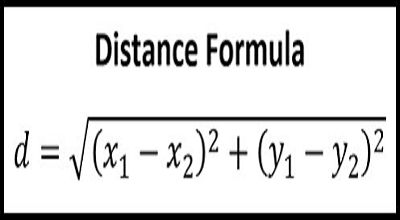Introduction to the Distance Formula
The distance formula is a mathematical expression used to determine the distance between two points in a Cartesian coordinate system. It is derived from the Pythagorean theorem. Plays a crucial role in geometry, physics, engineering, and many other fields where spatial relationships are important.
Historical Context and Development
Ancient Origins and Euclidean Geometry
The roots of the distance formula can be traced back to ancient Greek mathematics, particularly the works of Euclid, who laid down the foundational principles of geometry in his seminal work, “Elements”. Euclid’s work included propositions and theorems that provided a basis for understanding spatial relationships, including the concept of distance between points.
Pythagorean Theorem and Its Role
The Pythagorean theorem, formulated by the ancient Greek mathematician Pythagoras, states that in a right-angled triangle, the square of the length of the hypotenuse ccc is equal to the sum of the squares of the other two sides aaa and bbb: c2=a2+b2c^2 = a^2 + b^2c2=a2+b2
This theorem forms the basis for calculating distances between points in a coordinate system.
Derivation of the Distance Formula
Understanding Cartesian Coordinates
In a Cartesian coordinate system, any point PPP can be represented by an ordered pair (x,y)(x, y)(x,y). Where xxx denotes the horizontal position (abscissa) and yyy denotes the vertical position (ordinate).
Distance Between Two Points
Consider two points A(x1,y1)A(x_1, y_1)A(x1,y1) and B(x2,y2)B(x_2, y_2)B(x2,y2). To find the distance ddd between these points:
- Formulating the Difference in Coordinates
- The horizontal distance (difference in xxx-coordinates): Δx=x2−x1\Delta x = x_2 – x_1Δx=x2−x1
- The vertical distance (difference in yyy-coordinates): Δy=y2−y1\Delta y = y_2 – y_1Δy=y2−y1
- Applying the Pythagorean Theorem
- According to the Pythagorean theorem, the square of the distance ddd between AAA. BBB is given by: d2=Δx2+Δy2d^2 = \Delta x^2 + \Delta y^2d2=Δx2+Δy2
- Taking the Square Root
- Thus, the distance ddd between AAA and BBB is: d=Δx2+Δy2d = \sqrt{\Delta x^2 + \Delta y^2}d=Δx2+Δy2
This formula is known as the distance formula.
Geometric Interpretation
Visualization in Cartesian Plane
In a Cartesian plane:
- Points AAA and BBB are plotted based on their xxx- and yyy-coordinates.
- The distance ddd represents the straight-line distance (or Euclidean distance) between AAA and BBB.
Application in Geometry
- Lines and Segments: The distance formula is used to calculate distances between points on lines and segments.
- Polygons: It helps determine distances between vertices of polygons.
- Circles: For circles, the distance formula can determine distances between the center and any point on the circle.
Applications Across Disciplines
Engineering and Physics
- Mechanical Engineering: Used in designing mechanisms where precise distances between components are critical.
- Civil Engineering: Essential for surveying and determining distances between landmarks.
- Physics: Applied in kinematics to calculate distances traveled by objects.
Computer Science and Data Analysis
- Computer Graphics: Utilized to render objects in 2D and 3D spaces.
- Data Analysis: Measures distances between data points in statistical analysis and clustering algorithms.
Advanced Concepts and Modifications
Higher Dimensions
- The distance formula extends naturally to higher dimensions (3D, 4D, etc.) using the same principles.
Non-Euclidean Spaces
- In non-Euclidean geometries, such as spherical geometry. The distance formula is modified to suit the curvature of the space.
Practical Examples and Problem Solving
Example Problems
- Example 1: Calculate the distance between points A(2,3)A(2, 3)A(2,3) and B(5,7)B(5, 7)B(5,7). Δx=5−2=3\Delta x = 5 – 2 = 3Δx=5−2=3 Δy=7−3=4\Delta y = 7 – 3 = 4Δy=7−3=4 d=32+42=9+16=25=5d = \sqrt{3^2 + 4^2} = \sqrt{9 + 16} = \sqrt{25} = 5d=32+42=9+16=25=5
- Example 2: Determine if points A(1,2)A(1, 2)A(1,2), B(4,6)B(4, 6)B(4,6), and C(−2,0)C(-2, 0)C(−2,0) form a right triangle.
- Calculate distances ABABAB, BCBCBC, and ACACAC: AB=(4−1)2+(6−2)2=32+42=5AB = \sqrt{(4-1)^2 + (6-2)^2} = \sqrt{3^2 + 4^2} = 5AB=(4−1)2+(6−2)2=32+42=5 BC=(−2−4)2+(0−6)2=(−6)2+(−6)2=36+36=6BC = \sqrt{(-2-4)^2 + (0-6)^2} = \sqrt{(-6)^2 + (-6)^2} = \sqrt{36 + 36} = 6BC=(−2−4)2+(0−6)2=(−6)2+(−6)2=36+36=6 AC=(−2−1)2+(0−2)2=(−3)2+(−2)2=9+4=13AC = \sqrt{(-2-1)^2 + (0-2)^2} = \sqrt{(-3)^2 + (-2)^2} = \sqrt{9 + 4} = \sqrt{13}AC=(−2−1)2+(0−2)2=(−3)2+(−2)2=9+4=13
Conclusion
The distance formula is a versatile and essential tool in mathematics and its applications extend across various disciplines. Derived from the Pythagorean theorem. It provides a straightforward method to calculate distances between points in a Cartesian coordinate system. Understanding this formula is crucial for solving geometric problems. Engineering applications, and analyzing spatial relationships in both theoretical and practical contexts.
